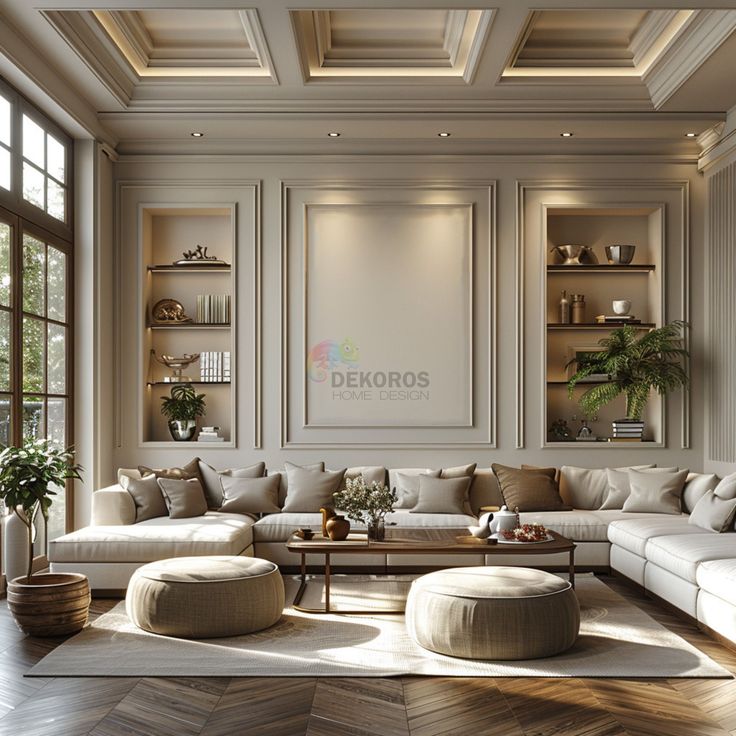1. Coffered Ceiling Design

What it is: A traditional sunken panel grid that is frequently accentuated with painted or wood trim.
Why it works: It gives formal dining areas and living rooms depth and elegance.
Pro Tip: To accentuate the texture, combine with recessed, soft lighting.
2. Wooden Beams

What it is: Fake or exposed wooden beams that give an industrial or rustic feel.
Why it functions: Ideal for adding warmth and character to open-concept homes or homes with high ceilings.
Pro Tip: For an environmentally responsible touch, use repurposed wood.
3. Tray Ceilings

What it is: a recessed pattern that builds layers by stepping upward.
Why it functions: gives dining rooms or bedrooms height and refinement.
Pro Tip: For added drama, use wallpaper or paint the recessed region a contrasting color.
4. Decorative Plasterwork or Moldings

What it is: Plaster medallions or elaborate designs.
Why it functions: gives historic homes a touch of old world charm.
Pro Tip: For a majestic look, highlight with a chandelier.
5. Metal or Tin Tiles

What it is: intricately designed tiles of pressed metal.
Why it functions: adds a retro-industrial look that works well in foyers and kitchens.
Pro Tip: To fit your environment, choose painted or polished finishes.
6. POP Ceiling with LED Lighting

What it is: An LED strip groove constructed into a tiered ceiling.
Why it functions: produces a contemporary, soft radiance that is perfect for media rooms or living areas.
Pro Tip: For versatility, use colorful, dimmable LEDs.
7. Painted or Wallpapered Ceiling Design

What it is: Vibrantly colored or patterned ceiling with a “fifth wall” effect.
Why it works: It gives any space personality and drama.
Pro Tip: To prevent overpowering the room, keep the walls neutral.
8. Vaulted Ceiling Design

What it is: An open, spacious atmosphere created by high, sloping ceilings.
Why it functions: accentuates the splendor of spacious living rooms or bedrooms.
Pro Tip: Fill the vertical area with chandeliers or pendant lights.
9. Glass Ceilings or Skylight Ceiling Design

What it is: Glass panels on ceilings that let in natural light.
Why it functions: Ideal for creating a calm ambiance in bathrooms or sunrooms.
Pro Tip: For privacy, go for frosted glass.
10. Wooden Slat or Lattice Ceiling Design

What it is: Patterns or rows of thin wooden slats.
Why it functions: gives a sleek, minimalist look that is perfect for contemporary houses.
Pro Tip: To keep smaller spaces light, use light-colored wood.
11. Geometric or 3D Ceilings Design

What it is: Distinct patterns such as waves, hexagons, or other striking patterns.
Why it functions: makes a focal point that is both artistic and futuristic.
Pro Tip: To stimulate creativity, use in workplaces or other creative settings.
12. Stenciled Ceiling Design

What it is: Paint or stencil patterns used for a personalized appearance.
Why it functions: Chic and affordable, perfect for kids’ rooms or bedrooms.
Pro Tip: For a hint of elegance, apply metallic paint.
13. Mirrored Ceiling Design

What it is: tiles or panels that reflect light to provide the appearance of additional space.
Why it functions: Ideal for little bathrooms or eating areas.
Pro Tip: To prevent overpowering the décor, use sparingly.
14. Acoustic Panel Ceiling Design

What it is: Panels that provide texture and cut down on noise.
Why it functions: Perfect for media rooms or home offices.
Pro Tip: To blend style with functionality, select fashionable panels.
15. Green Ceilings design

What it is: Artificial greenery or hanging plants mounted on ceilings.
Why it functions: adds a biophilic touch to kitchens and living areas.
Pro Tip: For simpler upkeep, use lightweight artificial plants.
